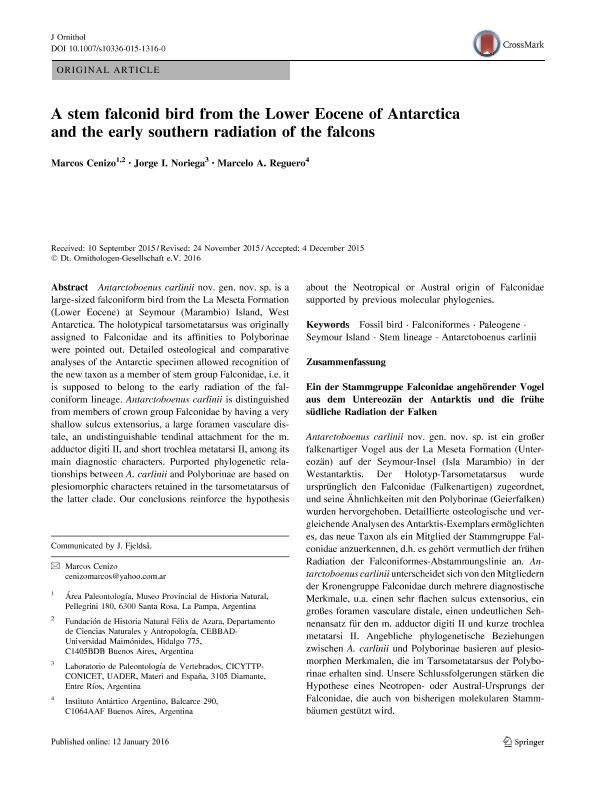Mostrar el registro sencillo del ítem
dc.contributor.author
Cenizo, Marcos
dc.contributor.author
Noriega, Jorge Ignacio

dc.contributor.author
Reguero, Marcelo Alfredo

dc.date.available
2018-08-03T20:53:35Z
dc.date.issued
2016-07
dc.identifier.citation
Cenizo, Marcos; Noriega, Jorge Ignacio; Reguero, Marcelo Alfredo; A stem falconid bird from the Lower Eocene of Antarctica and the early southern radiation of the falcons; Wiley Blackwell Publishing, Inc; Journal Fur Ornithologie; 157; 3; 7-2016; 885-894
dc.identifier.issn
1519-888X
dc.identifier.uri
http://hdl.handle.net/11336/54190
dc.description.abstract
Antarctoboenus carlinii nov. gen. nov. sp. is a large-sized falconiform bird from the La Meseta Formation (Lower Eocene) at Seymour (Marambio) Island, West Antarctica. The holotypical tarsometatarsus was originally assigned to Falconidae and its affinities to Polyborinae were pointed out. Detailed osteological and comparative analyses of the Antarctic specimen allowed recognition of the new taxon as a member of stem group Falconidae, i.e. it is supposed to belong to the early radiation of the falconiform lineage. Antarctoboenus carlinii is distinguished from members of crown group Falconidae by having a very shallow sulcus extensorius, a large foramen vasculare distale, an undistinguishable tendinal attachment for the m. adductor digiti II, and short trochlea metatarsi II, among its main diagnostic characters. Purported phylogenetic relationships between A. carlinii and Polyborinae are based on plesiomorphic characters retained in the tarsometatarsus of the latter clade. Our conclusions reinforce the hypothesis about the Neotropical or Austral origin of Falconidae supported by previous molecular phylogenies.
dc.description.abstract
Antarctoboenus carlinii nov. gen. nov. sp. ist ein großer falkenartiger Vogel aus der La Meseta Formation (Untereozän) auf der Seymour-Insel (Isla Marambio) in der Westantarktis. Der Holotyp-Tarsometatarsus wurde ursprünglich den Falconidae (Falkenartigen) zugeordnet, und seine Ähnlichkeiten mit den Polyborinae (Geierfalken) wurden hervorgehoben. Detaillierte osteologische und vergleichende Analysen des Antarktis-Exemplars ermöglichten es, das neue Taxon als ein Mitglied der Stammgruppe Falconidae anzuerkennen, d.h. es gehört vermutlich der frühen Radiation der Falconiformes-Abstammungslinie an. Antarctoboenus carlinii unterscheidet sich von den Mitgliedern der Kronengruppe Falconidae durch mehrere diagnostische Merkmale, u.a. einen sehr flachen sulcus extensorius, ein großes foramen vasculare distale, einen undeutlichen Sehnenansatz für den m. adductor digiti II und kurze trochlea metatarsi II. Angebliche phylogenetische Beziehungen zwischen A. carlinii und Polyborinae basieren auf plesiomorphen Merkmalen, die im Tarsometatarsus der Polyborinae erhalten sind. Unsere Schlussfolgerungen stärken die Hypothese eines Neotropen- oder Austral-Ursprungs der Falconidae, die auch von bisherigen molekularen Stammbäumen gestützt wird.
dc.format
application/pdf
dc.language.iso
eng
dc.publisher
Wiley Blackwell Publishing, Inc

dc.rights
info:eu-repo/semantics/openAccess
dc.rights.uri
https://creativecommons.org/licenses/by-nc-sa/2.5/ar/
dc.subject
Antarctoboenus Carlinii
dc.subject
Falconiformes
dc.subject
Fossil Bird
dc.subject
Paleogene
dc.subject
Seymour Island
dc.subject
Stem Lineage
dc.subject.classification
Meteorología y Ciencias Atmosféricas

dc.subject.classification
Ciencias de la Tierra y relacionadas con el Medio Ambiente

dc.subject.classification
CIENCIAS NATURALES Y EXACTAS

dc.title
A stem falconid bird from the Lower Eocene of Antarctica and the early southern radiation of the falcons
dc.title
Ein der Stammgruppe Falconidae angehörender Vogel aus dem Untereozän der Antarktis und die frühe südliche Radiation der Falken
dc.type
info:eu-repo/semantics/article
dc.type
info:ar-repo/semantics/artículo
dc.type
info:eu-repo/semantics/publishedVersion
dc.date.updated
2018-08-03T14:17:50Z
dc.journal.volume
157
dc.journal.number
3
dc.journal.pagination
885-894
dc.journal.pais
Reino Unido

dc.journal.ciudad
Londres
dc.description.fil
Fil: Cenizo, Marcos. Fundación de Historia Natural Félix de Azara; Argentina. Universidad Maimónides. Área de Investigaciones Biomédicas y Biotecnológicas. Centro de Estudios Biomédicos, Biotecnológicos, Ambientales y de Diagnóstico; Argentina
dc.description.fil
Fil: Noriega, Jorge Ignacio. Provincia de Entre Ríos. Centro de Investigaciones Científicas y Transferencia de Tecnología a la Producción. Universidad Autónoma de Entre Ríos. Centro de Investigaciones Científicas y Transferencia de Tecnología a la Producción. Consejo Nacional de Investigaciones Científicas y Técnicas. Centro Científico Tecnológico Conicet - Santa Fe. Centro de Investigaciones Científicas y Transferencia de Tecnología a la Producción; Argentina
dc.description.fil
Fil: Reguero, Marcelo Alfredo. Universidad Nacional de La Plata. Facultad de Ciencias Naturales y Museo. División Paleontología Vertebrados; Argentina. Ministerio de Relaciones Exteriores, Comercio Interno y Culto. Dirección Nacional del Antártico. Instituto Antártico Argentino; Argentina
dc.journal.title
Journal Fur Ornithologie

dc.relation.alternativeid
info:eu-repo/semantics/altIdentifier/doi/http://dx.doi.org/10.1007/s10336-015-1316-0
dc.relation.alternativeid
info:eu-repo/semantics/altIdentifier/url/https://link.springer.com/article/10.1007%2Fs10336-015-1316-0
Archivos asociados
